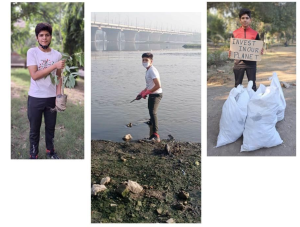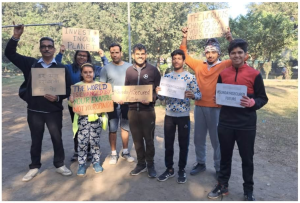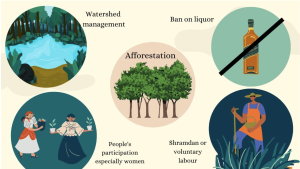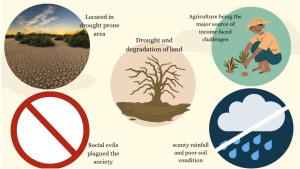8 Indigenizing Education for Climate Change
Stories from India
Dr. Laxmi N. Goparaju
Abstract
Recent years have witnessed transformations impacting many sectors of society due to climate change and its effects on the people and the environment. It has put at stake the basic amenities which mankind utilizes: energy, health, food/water security, and infrastructure development. As a result, countries are facing and will continue to face challenges. The approach to combat would be either to adapt to the changing scenario, which, in many cases is cost-prohibitive or take steps to mitigate the harmful effects. In this aspect, education and awareness of climate change play a vital role in bridging the gap between research and practice. This should be addressed at all levels of age, gender, race, and religion. There is a need to have a clear understanding between policymakers, stakeholders, and local communities. India, one of the most populated countries of the world, and one of the few megadiverse countries, has a long and cherished history where the indigenous people have played a major role in protecting the environment. The best lessons have been taught by tribal and local peoples. As time passed, the advent of technology has helped in propagating environmental education to the most rural villages. Further, many programs and initiatives by various organizations have assisted in bringing about transformations in society at large. A few of them need mention and are briefly described below.
At the School Level
The conceptualization of “green schools” by the World Summit on Sustainable Development (UNESCO Global Education Monitoring Report, n.d) is a first step in recognizing that such efforts be realized at an earlier stage. The schools are awarded under various categories, which make an effort to keep with the guidelines and ensure that they inculcate environmental sensitivity at an early stage via various activities that teach us how to be environmentally friendly. Various clubs at the school level help in propagating and creating awareness about the environmental issues typical of that area. Experts can further help in solving the problems.
The Green Schools Programme (GSP) is an initiative to develop the understanding of school-going children towards environmental protection. It gives an opportunity to students and teachers to adopt an environmentally friendly approach and practice it on their respective school campuses. Further, schools are encouraged to enter into an audit where they are evaluated on the judicious use of resources and wastage. The major themes which need to be addressed are air, energy, food, land, water and waste. Every year after the audit, the best-performing schools are selected to be awarded under different categories. This is an encouragement and inspiration for students and teachers to practice sustainability (Green Schools Programme, n.d.).
The curriculum developed for the green schools is in accordance with the National Council of Educational Research and Training of India. The aim is to incorporate practical aspects of the environment and sustainable development into our daily lives. This thought should not be treated as a separate entity but rather it should be embedded in our lives. To achieve this continuous effort by the school, students, teachers, parents and other stakeholders are needed who would work together through collaboration and participation. Resource books and guides have been developed for the teachers to follow.
The priorities listed for a green school are:
- The majority of the population of the school should use sustainable and non-polluting modes of transport to school. This may include any of the following: public transport, e-rickshaw, cycling, walking, etc.
- Energy-efficient lighting is encouraged inside the school premises. An approach to conserve energy by the use of alternate sources of energy is appreciated.
- Maintain the green cover in and around the school campus. Planting native species of plants and maintaining biodiversity is encouraged.
- To encourage healthy food and nutrition, it is preferred that the school serves cooked meals. Packaged foods should be avoided.
- Waste segregation and disciplined disposal, recycling of at least 90% waste is recommended. Wet waste should be composted and burning of waste should be prohibited.
Individual groups and NGOS
Many such environmental groups have been mushrooming around the globe. Greta Thunberg’s initiative of “Fridays for future” has been an inspiration for many young girls and boys. Similar local and indigenous groups have risen to the same cause, for example, “We Rise Together” started by a teenager Aarav Seth, of Ghaziabad, in India. This movement stands for three main causes: ‘Sunday4SecuredFuture’, ‘Helping Hand’ and ‘She Hygiene’. Of these, ‘Sunday4SecuredFuture’ is a movement kicked off by Seth to motivate young climate activists to take at least one climate action every Sunday. It was enthusiastically appreciated by many activists around the world.
As part of this initiative, they have carried out massive tree plantings along the roads, and the Yamuna river bank. Under this movement, Seth has planted more than 6,000 trees. They also distribute saplings on occasions and festivals, including birthdays and anniversaries, to encourage people to follow the mission of planting in our vicinity. Mr. Aarav Seth, the young activist, is the leader of this initiative, who has contributed in cleaning the river banks, “Clean Yamuna drive” and “Clean Hindon drive” which are located in Delhi and Ghaziabad respectively.
When the initiative ‘Sundays4SecuredFuture’ started, substantial participation of 9-10 volunteers was seen. Eventually, more and more people started participating in the tree-planting drives. School friends of Mr. Aarav also joined the movement. As of now, the team comprises mainly adult members, who accompany the plantation drives.
Depending upon the area, tree species to be planted are decided collectively. As Aarav Seth relayed, in an email interview, “In parks and along dividers, we plant native trees like Neem (Azadirachta indica), Jamun (Synzigium cumini), Kadam (Neolamarckia cadamba), Peepal(Ficus relegiosa), Banyan(Ficus bengalensis) etc. In societies or schools which we have collaborated with for some drives, we plant flower trees like Kaner (Nerium oleander), Hibiscus (China rose), Bottle brush (Callistemon citrinus) among others.”
After facing a few hurdles in the initial stages as people resisted planting, later on, the drives were successful as people encouraged plantation. Mr. Seth was supported by his parents, family and friends. Their work has brought about a community-level impact as more and more people have joined their initiatives to propagate the change. Apart from this he has contributed in the cleaning of banks of River Yamuna and Hindon where the plastic waste has been removed along the banks. In this respect, the “We Rise Together” has collaborated with many organizations.
Seth and his friends play a major role in creating awareness among the common people. Diwali is a festival (festival of lights in India) when firecrackers are burnt far and wide as a part of the celebration. This enhances air pollution and creates a detrimental environment in the coming winter months. Aarav’s “#Ring the doorbell” campaign is creating consciousness among the people to celebrate a pollution-free Diwali this year onwards. They use placards at metro stations to highlight the cause and request people to follow simple celebrations.
“She Hygiene”, another program helps underprivileged girls to access sanitary napkins which are compostable. In a country like India, there are many girls in rural areas who cannot afford good hygiene during the menstruation period. The effort by this group has increased awareness and around 250 -300 girls are benefitted every month as compostable sanitary pads are distributed. They usually collaborate with schools that teach deprived children about the initiative, it is usually in nearby areas. Through the awareness sessions, they have, gradually, broken down the taboo embedded in the minds of those girls surrounding menstruation. Figure 1 and 2 shows the work of Mr. Aarav Seth.


Village and community level
In a small village in Maharashtra State of India, which faced drought for many years, Mr. Anna Hazare, led the village in starting to practice watershed management. And with community participation, it transformed into a semi-arid village and has set an example for the rest of the country. Agriculture prospered and so did the livelihoods which revolved around it. With the assistance of renewable energy and its adaptation, it has become a self-sustained village.
The story of Ralegan Siddhi village dates back to 1970’s when the village suffered drought and desertification at large and faced many social problems. Mr.Anna Hazare, after retirement from Army, returned to his village. Seeing its plight, he was determined to transform it. He discovered that water scarcity was the root cause of the problem. The fact is that it is located in the drought prone area of Parner Tehsil, in Ahmednagar district of Maharashtra. It receives inconsistent rainfall and for very limited days of the year. Coupled with undulating terrain, poor soil and depth, the rainwater struggles to percolate. It was challenging as agriculture was the main source of income for the villagers.
Hazare argued that water conservation would solve many of the problems associated. He suggested the construction of Nallah bunds (open drains) to control surface runoff as a first step. He motivated villagers to offer free labour (Shramdam) to meet the costs of constructing the six Nallah bunds. Each new task was divided among the villagers, and the amount of time was decided for each to spend in contribution. This ensured equal participation and equal opportunity and a fair methodology to engage people. People participated, and became a part of the solution rather than brooding over the problem. It gave a sense of ownership and pride.
Trees were planted in the vicinity of the bunds and tanks to increase percolation. This resulted in an increase in the water table giving way to harness it through wells. Through the cooperation of farmers and villagers, community wells originated which were useful for irrigation. Soon the farmers could practice multiple cropping, rather than single crop. The village was divided into four watersheds and community participation helped in monitoring them with assistance from experts of the government from time to time. Besides, many local governing bodies were formed like Pani Panchayat, Tarun Mandal (youth team), Gram Sabha which assisted in activities like water conservation and afforestation in the village. Women-centric issues were given importance and they were included in decision-making. Women’s empowerment aided in running the society.
Now, after more than four decades, the village is independent and sustainable fighting back poverty and food security and stands as an example of a sustainable modern village under the leadership of Mr. Anna Hazare. Figure 3 and figure 4 describe the situation before and after the transformation.


Digital Movements
We have now entered into a digital era, where we can communicate and connect with the remotest persons on Earth. Besides, various satellites in space have provided us with ample data to harness and study the environment, atmosphere, land, and oceans. Mapping of all the features on the surface of the Earth has been a reality and with the use of various tools and digital techniques, we are monitoring and measuring the changes. Integrating satellite data with ground truth, then bringing the data to a web platform and generation of user-friendly applications has educated the common man about the changing environment. Thus, the data analyzed can be used for making informed decisions and avoiding some natural disasters. Social media has played a vital role in spreading awareness about the changing climate, connecting the dots, as well as the different geographies of the world.
Connecting digitally on a common platform across boundaries is possible via the Internet. One such example is the International Centre for Integrated Mountain development (ICIMOD) which is an intergovernmental Institution. It has taken initiative to address issues related to sustainability, food security, enhancing livelihoods and respecting culture along the Hindukush Himalaya region. It is a portal where knowledge is shared with the participating nations Afghanistan, Bhutan, Bangladesh, China, India, Myanmar, Nepal and Pakistan.
Conclusion
The above examples have highlighted the aspect that we need to tap our indigenous knowledge and bring forth its essence by practicing it. If such environmentally friendly thoughts are inculcated in early childhood, I am sure we can look for a bright future. Every individual’s participation is important to bring a change in the society. Technology has played its role in bringing such indigenous knowledge onto one platform which can be shared across geographies. Thus, we can envision a future where indigenous knowledge, people’s participation, and technology blend together to provide us nature-based solutions for the conservation of natural resources.
References
Green Schools Programme. (n.d.). What is the GSP Audit? Green Schools Programme. https://www.greenschoolsprogramme.org/schools/gsp-audit/what-is-the-gsp-audit/
UNESCO Global Education Monitoring Report. (n.d.). All learners should have access to schools that are green. https://www.unesco.org/gem-report/en/monitoring-commitments-green-schools
Acknowledgments
I am grateful to Mr. Aarav Seth for providing information about his work via Interview.

